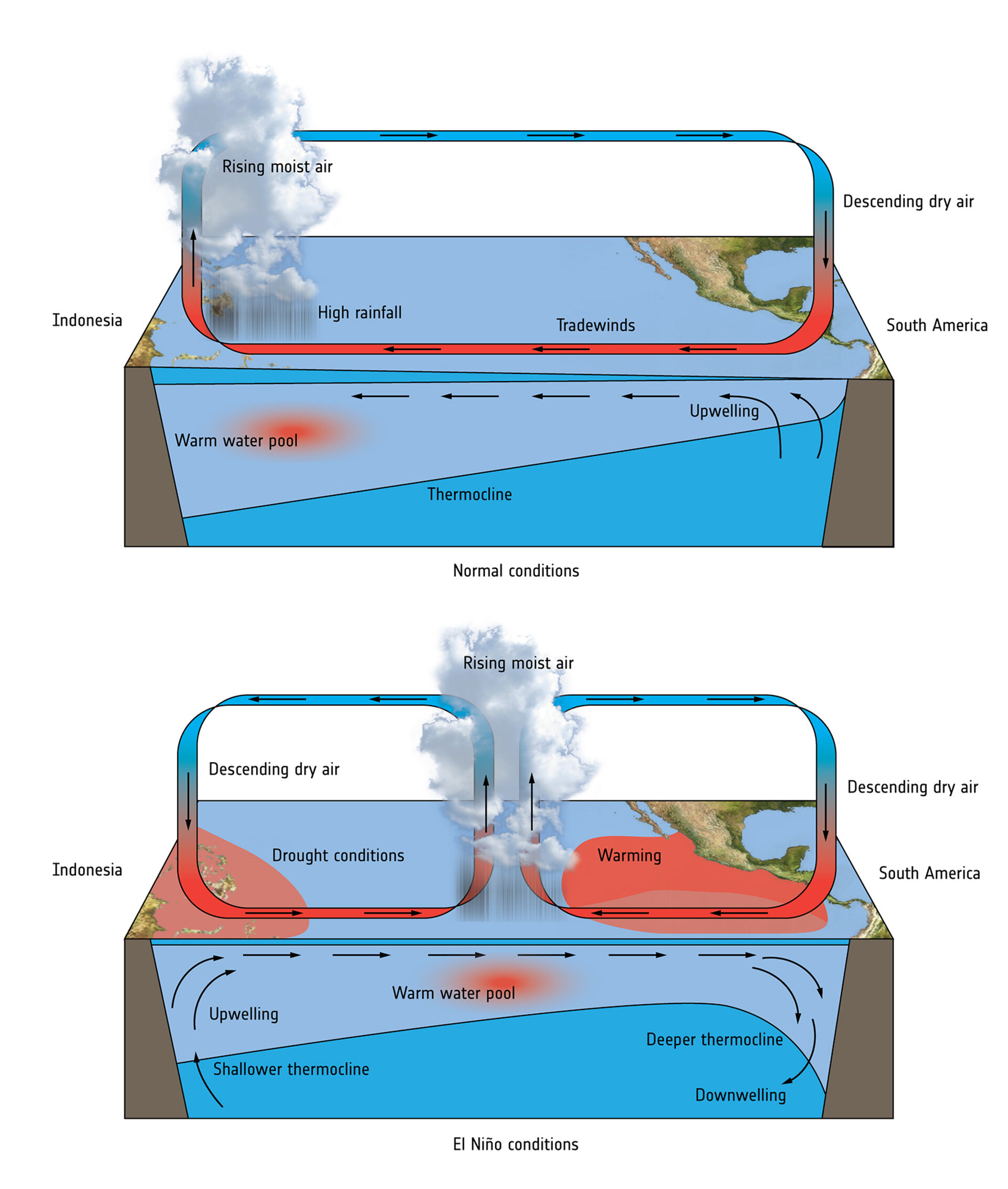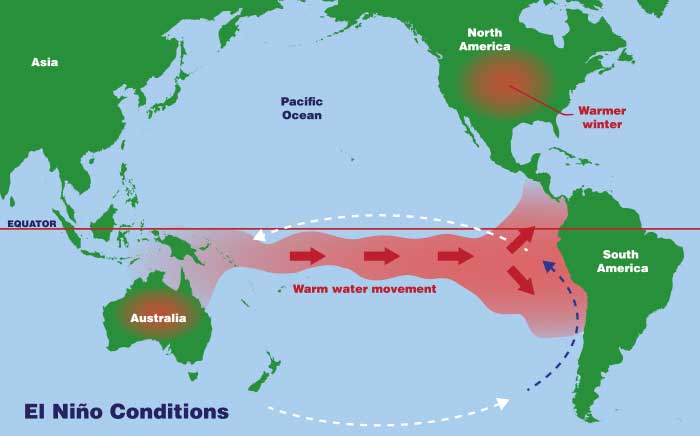EL NINO AND IT'S EFFECT
During normal conditions in the Pacific ocean, trade winds blow west along the equator, taking warm water from South America towards Asia. To replace that warm water, cold water rises from the depths — a process called upwelling. El Niño and La Niña are two opposing climate patterns that break these normal conditions. Scientists call these phenomena the El Niño-Southern Oscillation (ENSO) cycle. El Niño and La Niña can both have global impacts on weather, wildfires, ecosystems, and economies. Episodes of El Niño and La Niña typically last nine to 12 months, but can sometimes last for years. El Niño and La Niña events occur every two to seven years, on average, but they don’t occur on a regular schedule. Generally, El Niño occurs more frequently than La Niña.
El NINO
El Niño is a climate pattern that describes the unusual warming of surface waters in the eastern tropical Pacific Ocean. El Nino is the “warm phase” of a larger phenomenon called the El Nino-Southern Oscillation (ENSO). El Nino is a Spanish word. The term El Nino basically means ‘the child’. This is due to the fact that this current starts to flow around Christmas and hence the name referring to baby Christ.
History
El Niño has an impact on ocean temperatures, the speed and strength of ocean currents, the health of coastal fisheries, and local weather from Australia to South America and beyond. El Niño events occur irregularly at two- to seven-year intervals. However, El Niño is not a regular cycle, or predictable in the sense that ocean tides are.
El Niño was recognized by fishers off the coast of Peru as the appearance of unusually warm water. We have no real record of what indigenous Peruvians called the phenomenon, but Spanish immigrants called it El Niño, meaning “the little boy” in Spanish. When capitalized, El Niño means the Christ Child, and was used because the phenomenon often arrived around Christmas. El Niño soon came to describe irregular and intense climate changes rather than just the warming of coastal surface waters.
Led by the work of Sir Gilbert Walker in the 1930s, climatologists determined that El Niño occurs simultaneously with the Southern Oscillation. The Southern Oscillation is a change in air pressure over the tropical Pacific Ocean. When coastal waters become warmer in the eastern tropical Pacific (El Niño), the atmospheric pressure above the ocean decreases. Climatologists define these linked phenomena as El Niño-Southern Oscillation (ENSO). Today, most scientists use the terms El Niño and ENSO interchangeably.
Scientists use the Oceanic Nino Index (ONI) to measure deviations from normal sea surface temperatures. El Niño events are indicated by sea surface temperature increases of more than 0.9° Fahrenheit for at least five successive three-month seasons. The intensity of El Niño events varies from weak temperature increases (about 4–5° F) with only moderate local effects on weather and climate to very strong increases (14–18° F) associated with worldwide climatic changes.
El NINO occurs:-
An El Niño condition occurs when surface water in the equatorial Pacific becomes warmer than average and east winds blow weaker than normal. The opposite condition is called La Niña. During this phase of ENSO, the water is cooler than normal and the east winds are stronger. El Niños typically occur every 3 to 5 years.
Effects:-
The main impacts of El Niño occurring in and around the Tropics. The following are some of the effects El Niño has on the weather in this part of the world:
1.In South America, there is a drastic increase in the risk of flooding on the western coast, while there is an increase in the risk of droughts on parts of the eastern coast.
2.In eastern countries, like India and Indonesia, there is an increase in droughts.
3.In general, El Niño causes vast amounts of rainfall in the eastern parts of the Pacific (the western coast of South America), and very dry weather on the western parts (India, Indonesia).
4.With all the extra heat at the surface of the Pacific Ocean, energy is released into the atmosphere, causing an overall warming of the global climate temporarily. Years in which El Niño occurs tend to feature higher temperatures across the globe.
5.The effects of El Niño on the weather peak in December and can last for several months after that.
After El Niño, the trade and easterly winds often fall back into their normal, self-perpetuating cycle.
However, on some occasions, the effect is reversed in a process called La Niña. During La Niña, the trade winds are strengthened, causing the normal cycle to be more dramatic and having the reverse effect of El Niño.
Source:- climatology of savindra singh,NCERT,NOAA,
,












0 Comments